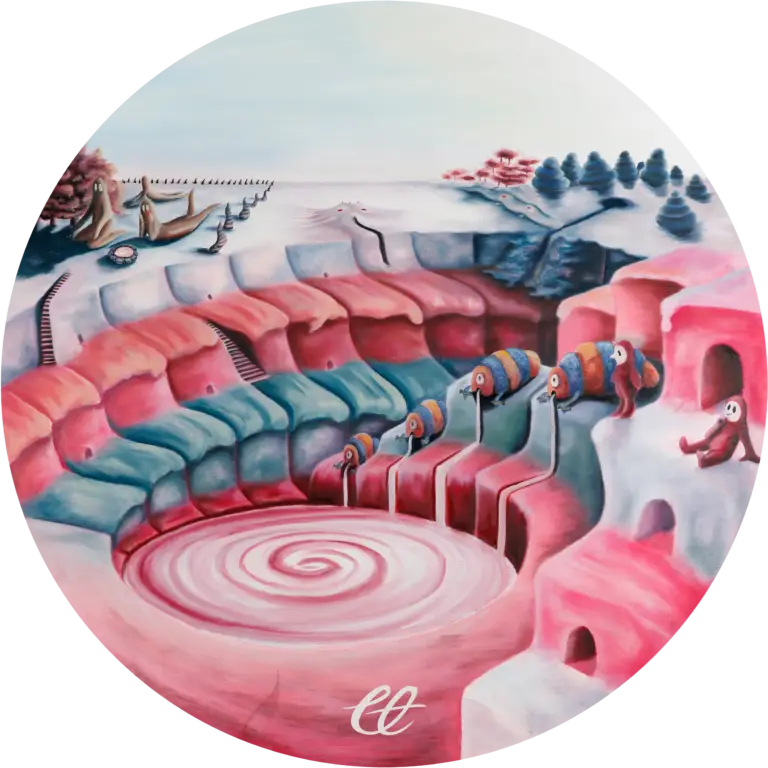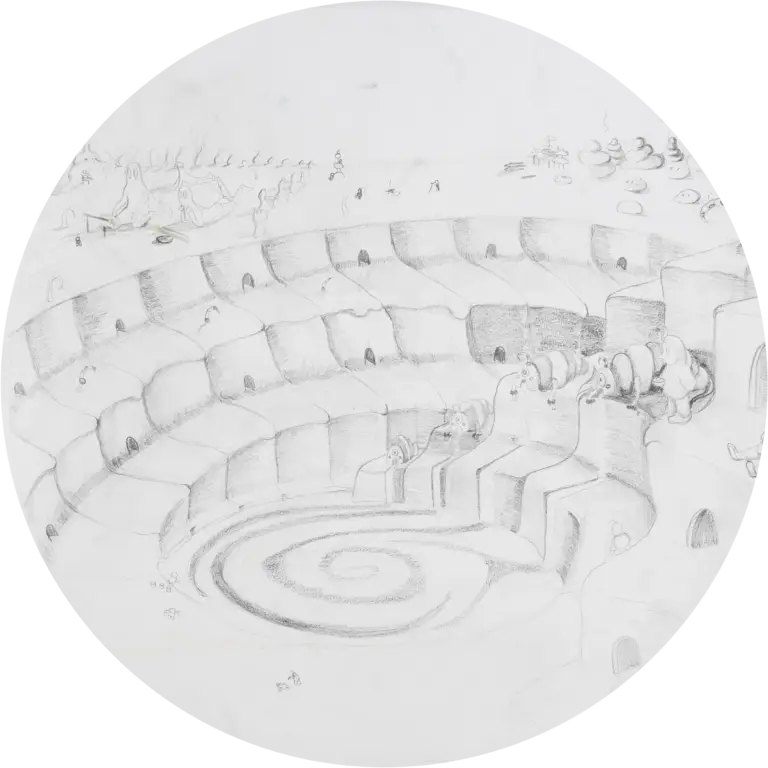

Industry
Oil painting on a wood panel measuring 36″
By Corrine Anderson
“Society begins with the emergence of government, the exchange of goods, a form of religion, and a settlement. Industry grows with the enslavement of the ‘Kurros’, a docile species known for their delicious saliva.“
In this post, I take a closer look at ‘Industry‘, the third piece in the ‘Fall Down‘ series. If you love this piece, I offer high-quality canvas prints in my shop. Thank you for your support!
Fall Down, Part Three
By the time I reached this stage in the series, I was hitting a bit of a wall. Keep in mind, these paintings were enormous, and I had just 3.5 months to complete all of them. That sounds like a lot of time, but when you factor in the five other classes I was taking, and—oh yes—sleeping, it really wasn’t much. I was staying up until at least 2 a.m. most nights, and the stress was real. I refused to let this series fall short of the vision I had in my mind. Painting is everything to me, and bringing what’s in my head to life is always my primary motivation.
But I’ll admit, by around month two, I was burnt out. This painting needed to be done in time for the halfway critique, and I think I had only about two weeks left to finish The Seven Deadly Sins, draw this new concept, and paint it. Time management is crucial when working under deadlines, and I had definitely lost track at this point. However, I wasn’t going to let that stop me—the story had to continue. Thankfully, I already had a clear idea of what I wanted to do next.
At this point in the series, I realized I was essentially painting a chronological history of humanity. I had covered birth, the development of their “manzmanity,” and now… what came next? The start of their civilization, of course! The tricky part was that I was making it up as I went along. I didn’t know exactly what the next concept would be until I finished the previous one. As the deadline loomed, I started brainstorming. I thought about humanity and where we are today—about colonization, and how the Europeans came to North America, destroying a once peaceful world. They developed it, enslaved people, and justified it all in the name of God. I also thought about the modern-day meat and dairy industry and the horrific treatment of animals—ruthlessly exploited for their resources.
This theme became the central idea for the painting. By this point in the timeline, the Manz were developing their first civilization. Visually, I wanted something that felt connected to our world but still otherworldly. I thought about ancient civilizations that built their homes in the mountains, with winding roads traveling through different levels. I felt this would be visually striking and create a compelling composition. Additionally, many early civilizations built their homes near rivers, close to vital resources. But I’ll admit, I had no idea how to begin. In a moment of frustration, I drew a swirl—then another one, and a vortex spiraling upwards. It’s funny—I’ve noticed that some of my best ideas come when I have no idea what I’m doing. I’m very much a “go with the flow” artist.
In terms of composition, I wanted to maintain consistency from previous pieces. It helped keep the story flowing. So, at the top of the painting, I included elements from earlier works. The Manz’s birthplace is now far away, symbolizing how they’ve abandoned their origins. The once-pristine sin garden has now become a dark, ominous hole, as if the evil from the past is seeping into the ground. A dark mass pulses and grows from the crack in the earth—evil that can no longer be contained. In the top left, the god Self has multiplied, and the Manz have adopted an entire religion. They’ve forsaken their morals in the name of Self and enslaved the Kurros beneath them.
The Kurros are gentle, docile creatures inspired by cows. They produce a milk-like substance that is sweet and nutritious, becoming the Manz’s main food source. As the population and civilization grew, the Manz needed a “better” method of extracting their food. They captured the peaceful Kurros and chained them to their tiers, prodding them relentlessly. The milk is collected in a large, circular reservoir, constantly stirred to maintain its freshness. The Manz sleep soundly at night, their bellies full, but at the expense of an entire species. They are content, because Self has told them so. The Selves are offered sacrifices at their place of worship, pleased with the Manz’s progress.
By now, the series had evolved significantly in terms of story, so when painting this piece, I wanted to emphasize an ominous tone. The sky is dull, devoid of color. In terms of the narrative, it’s now late afternoon—just before the sun disappears, as if light and hope have abandoned the world. Who knows if the sun will return the next day? The Manz have dug into the earth, and the further they go, the darker it gets. The gods, Self, cast their long shadows, symbolizing their negative influence on the world. And as mentioned earlier, evil is exuding from the garden where the sins once took root. Dark, fleshy, mold-like energy seeps from the crack in the earth, signaling that nothing good can come from this.
I had the least amount of time to work on this painting compared to the others, and there was so much more I wanted to capture visually. A recurring theme for me in this series is that I always wish I had painted more Manz. I also wish I had more time to make the painting even more ominous. But, time was up, and it was time to move on to the fourth piece. The halfway critique was over, but I was certainly not finished.
Thank you for reading part three of my six-part series, Fall Down! I’m thrilled to share this journey with you, and I hope you’re as excited as I am to see what happens next. Don’t miss out—sign up for my newsletter to stay updated on new content and be the first to know when part four is released!
Fall Down, Part Three
By the time I reached this stage in the series, I was hitting a bit of a wall. Keep in mind, these paintings were enormous, and I had just 3.5 months to complete all of them. That sounds like a lot of time, but when you factor in the five other classes I was taking, and—oh yes—sleeping, it really wasn’t much. I was staying up until at least 2 a.m. most nights, and the stress was real. I refused to let this series fall short of the vision I had in my mind. Painting is everything to me, and bringing what’s in my head to life is always my primary motivation.
But I’ll admit, by around month two, I was burnt out. This painting needed to be done in time for the halfway critique, and I think I had only about two weeks left to finish The Seven Deadly Sins, draw this new concept, and paint it. Time management is crucial when working under deadlines, and I had definitely lost track at this point. However, I wasn’t going to let that stop me—the story had to continue. Thankfully, I already had a clear idea of what I wanted to do next.
At this point in the series, I realized I was essentially painting a chronological history of humanity. I had covered birth, the development of their “manzmanity,” and now… what came next? The start of their civilization, of course! The tricky part was that I was making it up as I went along. I didn’t know exactly what the next concept would be until I finished the previous one. As the deadline loomed, I started brainstorming. I thought about humanity and where we are today—about colonization, and how the Europeans came to North America, destroying a once peaceful world. They developed it, enslaved people, and justified it all in the name of God. I also thought about the modern-day meat and dairy industry and the horrific treatment of animals—ruthlessly exploited for their resources.
This theme became the central idea for the painting. By this point in the timeline, the Manz were developing their first civilization. Visually, I wanted something that felt connected to our world but still otherworldly. I thought about ancient civilizations that built their homes in the mountains, with winding roads traveling through different levels. I felt this would be visually striking and create a compelling composition. Additionally, many early civilizations built their homes near rivers, close to vital resources. But I’ll admit, I had no idea how to begin. In a moment of frustration, I drew a swirl—then another one, and a vortex spiraling upwards. It’s funny—I’ve noticed that some of my best ideas come when I have no idea what I’m doing. I’m very much a “go with the flow” artist.
In terms of composition, I wanted to maintain consistency from previous pieces. It helped keep the story flowing. So, at the top of the painting, I included elements from earlier works. The Manz’s birthplace is now far away, symbolizing how they’ve abandoned their origins. The once-pristine sin garden has now become a dark, ominous hole, as if the evil from the past is seeping into the ground. A dark mass pulses and grows from the crack in the earth—evil that can no longer be contained. In the top left, the god Self has multiplied, and the Manz have adopted an entire religion. They’ve forsaken their morals in the name of Self and enslaved the Kurros beneath them.
The Kurros are gentle, docile creatures inspired by cows. They produce a milk-like substance that is sweet and nutritious, becoming the Manz’s main food source. As the population and civilization grew, the Manz needed a “better” method of extracting their food. They captured the peaceful Kurros and chained them to their tiers, prodding them relentlessly. The milk is collected in a large, circular reservoir, constantly stirred to maintain its freshness. The Manz sleep soundly at night, their bellies full, but at the expense of an entire species. They are content, because Self has told them so. The Selves are offered sacrifices at their place of worship, pleased with the Manz’s progress.
By now, the series had evolved significantly in terms of story, so when painting this piece, I wanted to emphasize an ominous tone. The sky is dull, devoid of color. In terms of the narrative, it’s now late afternoon—just before the sun disappears, as if light and hope have abandoned the world. Who knows if the sun will return the next day? The Manz have dug into the earth, and the further they go, the darker it gets. The gods, Self, cast their long shadows, symbolizing their negative influence on the world. And as mentioned earlier, evil is exuding from the garden where the sins once took root. Dark, fleshy, mold-like energy seeps from the crack in the earth, signaling that nothing good can come from this.
I had the least amount of time to work on this painting compared to the others, and there was so much more I wanted to capture visually. A recurring theme for me in this series is that I always wish I had painted more Manz. I also wish I had more time to make the painting even more ominous. But, time was up, and it was time to move on to the fourth piece. The halfway critique was over, but I was certainly not finished.
Thank you for reading part three of my six-part series, Fall Down! I’m thrilled to share this journey with you, and I hope you’re as excited as I am to see what happens next. Don’t miss out—sign up for my newsletter to stay updated on new content and be the first to know when part four is released!
Canvas prints
Buzzin’ Here Mouse pad
$15.00
Early Bird Unisex Tee
$30.00
Early Bird Mouse Pad
$15.00
Early Bird Crop Hoodie
$50.00 – $52.00Price range: $50.00 through $52.00
Early Bird Micro Tank
$35.00
Early Bird Mug
$15.00
